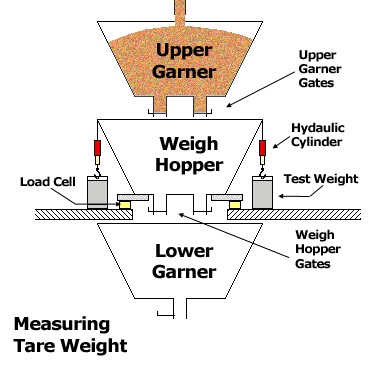All official weighing of loose grain is performed on bulk-weighing scales. A diagram of such a scale follows. The grain is weighed in a bin called the "Weigh Hopper," which in modern automatic scales is supported by load cells. The load cells generate an electrical signal proportional to the weight they support. A device called a "Scale Indicator" supplies power to the load cells, sums their output, and produces a digital signal which represents the combined weight of the grain and weigh hopper. The flow of grain into or out of the weigh hopper is controlled by slide gates. A scale control computer records the output of the scale indicator, subtracts off the weight of the hopper itself, and operates the gates.

The scale is shown going through its normal weighing cycle. The weight of the empty weigh hopper (the TARE weight) is measured with the upper garner and weigh hopper gates closed. The scale indicator sends the tare weight to the scale control computer, which waits until the weight readings are stable, showing that the weigh hopper is not moving and grain is neither entering nor leaving the weigh hopper, and records the tare weight. During this time, grain being carried to the scale accumulates in the upper garner. The storage available in the upper garner keeps the elevator from having to constantly stop and start its conveyors.
After the scale control computer has recorded a valid tare, it opens the upper garner gates to allow grain into the weigh hopper. The indicator continually sends weight readings to the computer, which closes the upper garner gates when the weight passes a pre-set cutoff value. The computer again waits until the weight is stable and records the weight of the grain and hopper combined (the GROSS weight).
After recording a valid gross weight, the scale control computer opens the weigh hopper gates. Grain drains rapidly into the lower garner, which normally is simultaneously discharging to a duct or a conveyor. The lower garner discharges the grain at a slower rate than the weigh hopper, preventing it from overloading the conveyors downstream. When the weight readings from the indicator go below a pre-set lower cutoff value, the computer closes the weigh hopper gates and records another tare. Then the cycle repeats.
The net weight of the grain is the difference between the gross and the tare. When a scale is receiving inbound grain, the control computer takes a gross weight and subtracts the preceding tare weight to obtain the net weight. This gives the true net weight received, because any grain already in the weigh hopper at the beginning of weighing is subtracted out and not counted. When the scale is weighing outbound grain, the computer takes each gross and subtracts the following tare. This gives the true net weight of grain shipped, because any grain remaining in the weigh hopper at the end of weighing is subtracted out and not counted.
Related topics
- Operation of an Export Elevator
- Operation of a Diverter Type sampler
- Electronic Monitoring and Control Systems
- Testing a Bulk Weighing Scale
- Virtual Reality Models

